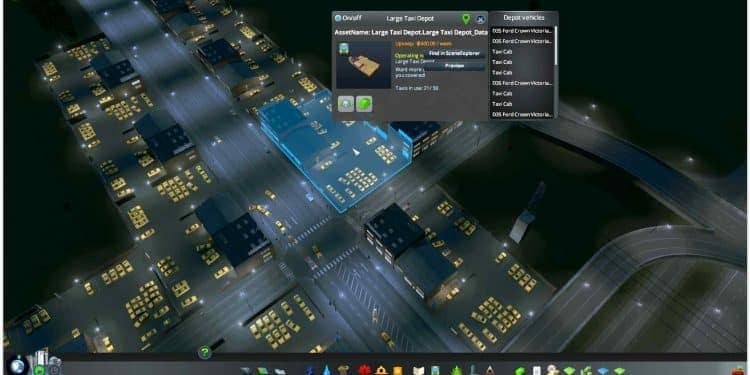Cities: Skylines includes transportation as one of the available services. There are many other kinds of transportation that can be accessed via milestones. You can create a transport system, dig underground tunnels, set up passenger and cargo rail tracks, construct both cargo and passenger ship ports, and construct an airport.
Internal subway and bus networks serve passengers and cargo trains, whereas railway networks can serve all internal and regional demands. Intercity links are provided through the docks and airports.
The taxis, on the other hand, are a relatively new service that lets tourists and people order cabs to bring passengers to their desired location.
Cabs operate similarly to private cars, with the exception that taxis are housed at a station and wait for the new passengers on stands. Taxis make it much easier for tourists to navigate around the city and encourage them to remain longer in the city, resulting in increased tax revenue.
Taxis are essential in commercial specialty areas. An efficient taxi system will be used by visitors visiting tourism districts and inhabitants in leisure areas. In this article, we will mention everything you need to know about Taxis in Cities: Skylines. Continue reading to learn more.
How Many Passengers Can A Taxi Hold?
A standard cab can only serve a single passenger at a time. A working shift for each cab consists of transporting ten customers. Also, when there are no more passengers to pick up, the shift could be terminated at any time.
A taxi would proceed to the closest taxi stand when it becomes ‘available.’ Every cab would proceed to its depot if there are no stands around. Taxis belong to one depot and can not be transferred to the other.
Taxis also are essential in dealing with the increasingly specialized fields. Tourists want to reach tourist attractions quickly, so getting a great number of taxi cabs on hand makes their lives much easier. Taxis don’t really wait in lines; instead, they get demand from visitors and citizens then immediately drive to pick up the passengers.
When a taxi does not have a new passenger in the queue, it will proceed to the closest taxi stand to await a request if a work shift remains available. Taxis return to the depots only at the end of each shift for repair.
This makes taxis extremely adaptable, and they can be extremely useful when it comes to ensuring that tourists and residents without automobiles have easy access to all areas of your city.
Also read: What is the Most Efficient City Layout in Cities: Skylines?
Spawning The Taxis

Each depot will generate each available taxi if there is more demand for them. Placing many depots in one spot at the same time without any other taxis on the road will result in a Taxiwave. Since each vehicle is not planned like a train or bus to stand in line for the last one in a line to go, taxi waves will cause traffic jams.
Taxis can also have unusually long shifts if you’re not using any despawn mods enabled. A taxi could wait for passengers continuously; it may theoretically be parked at a stop for the duration of its shift.
Taxis appear to be tied from the day and night cycle, with even more passengers being picked up at night than during the daytime. During the night, a large number of tourists appear to request them.
Single passengers would be allocated to each cab at a time. When one passenger has been answered to, no further taxis can pick them up. Other taxis will cheerfully disregard potential clients who’ve been waiting for a trip as a result of this.
Productivity
If you boost the Taxi budget, additional cabs will appear at the depots. A 25 percent increase in capacity is achieved by increasing the budget by 150 percent. You can raise the number of cabs available for each depot from 100 to 125 if you already have 100 available. Building more depots and adjusting the balance for nighttime vs. daytime is much more cost-effective.
Five vehicles can be accommodated on a single stand. Having a better ratio as well as spacing out enough stands could considerably reduce the time it takes taxis to travel back to a depot, cluttering up your roads unnecessarily.
If you intend to use the depots directly in central places, you must have five or even more stands for each facility. Keep in mind that, as previously mentioned, only taxis operated by a depot are permitted to enter, whereas stands can accommodate any cab.
Also read: What is a Fresh Water Outlet and Where Can You Find it?
Taxi Waves

Because each taxi has a long shift with ten different passengers, each shift with each cab will take around the same length of time, based on the city’s layout.
As a result, taxi waves act similarly to waves. When you spawn 100 of them at one time, they will all go to their depot after their shift. Before a taxi resumes driving, a timer begins to run for about thirty seconds. This results in a brief but severe drop in availability.
To avoid waves, gradually increase your capacity, particularly after the first 25-50 cabs have completed their shifts. Distribute your depots as well as stands in a uniform manner. Putting them all in one place is the most efficient method.
Final Thoughts
You can use a variety of other vehicles, but taxis are a wonderful addition to the game, which provides your streets a ‘larger’ look. The article mentioned above contains all of the necessary information as well as comprehensive guidance on the topic.



